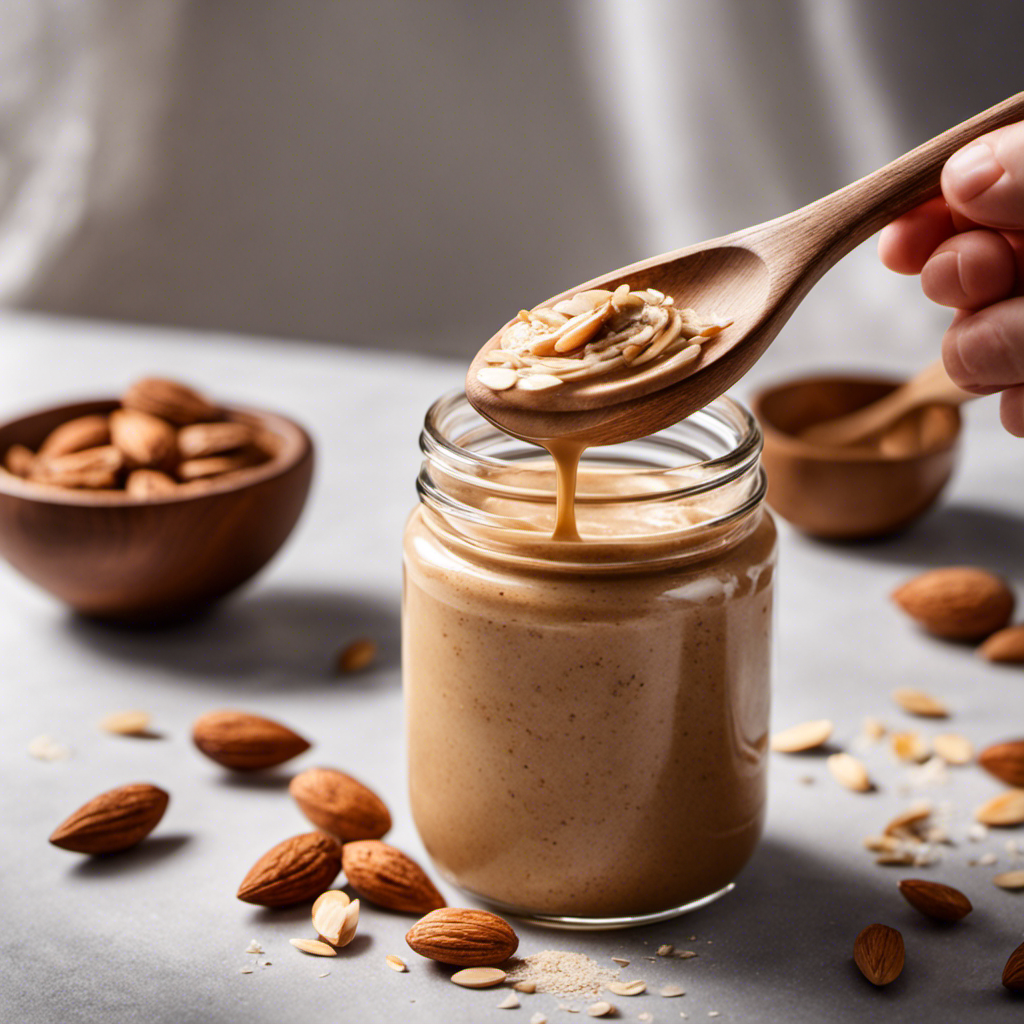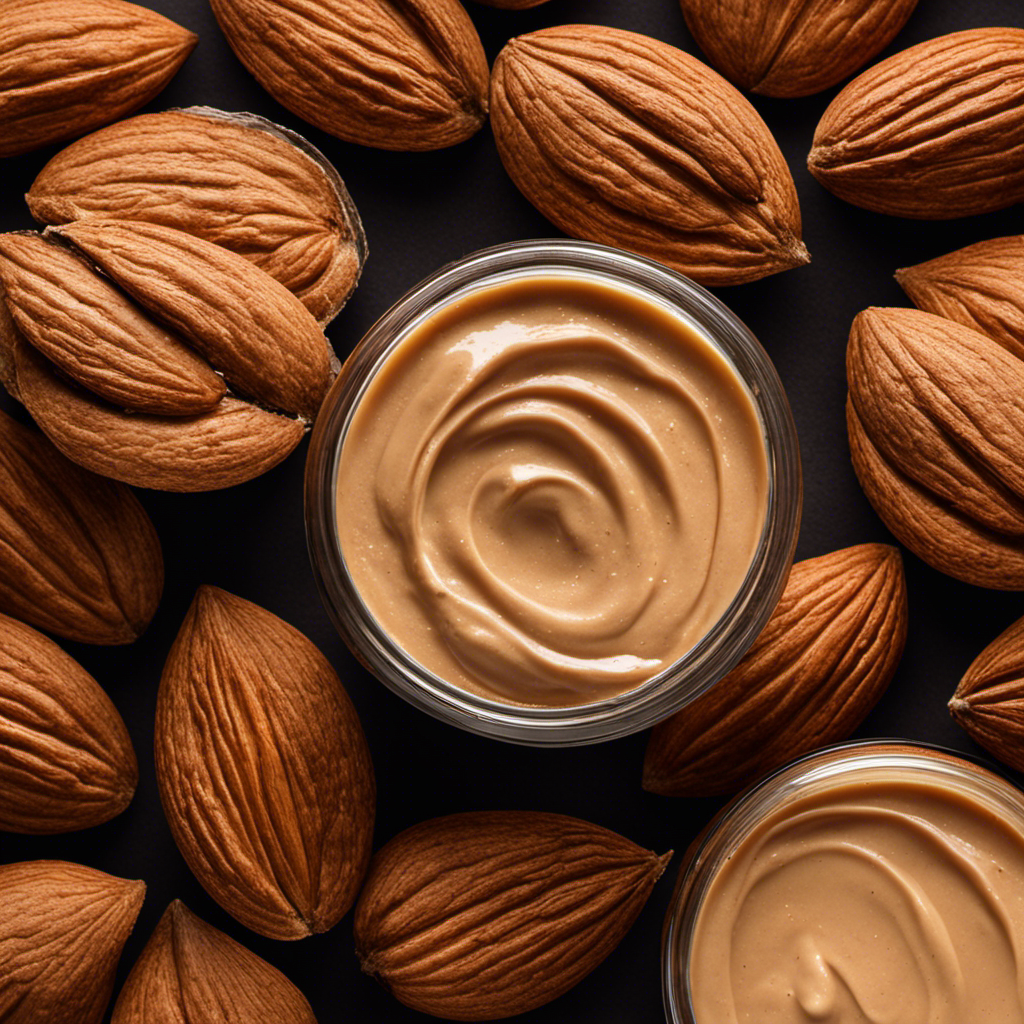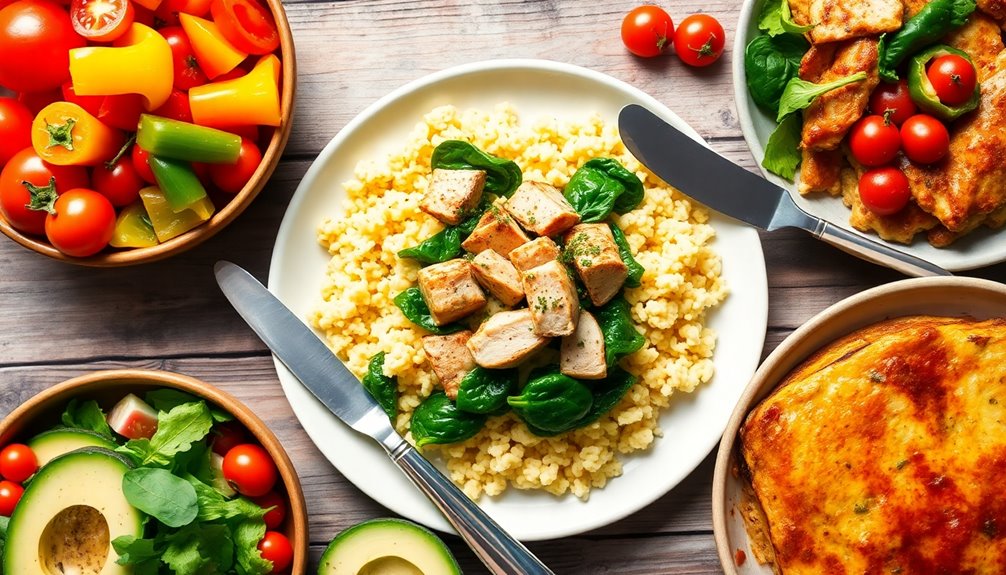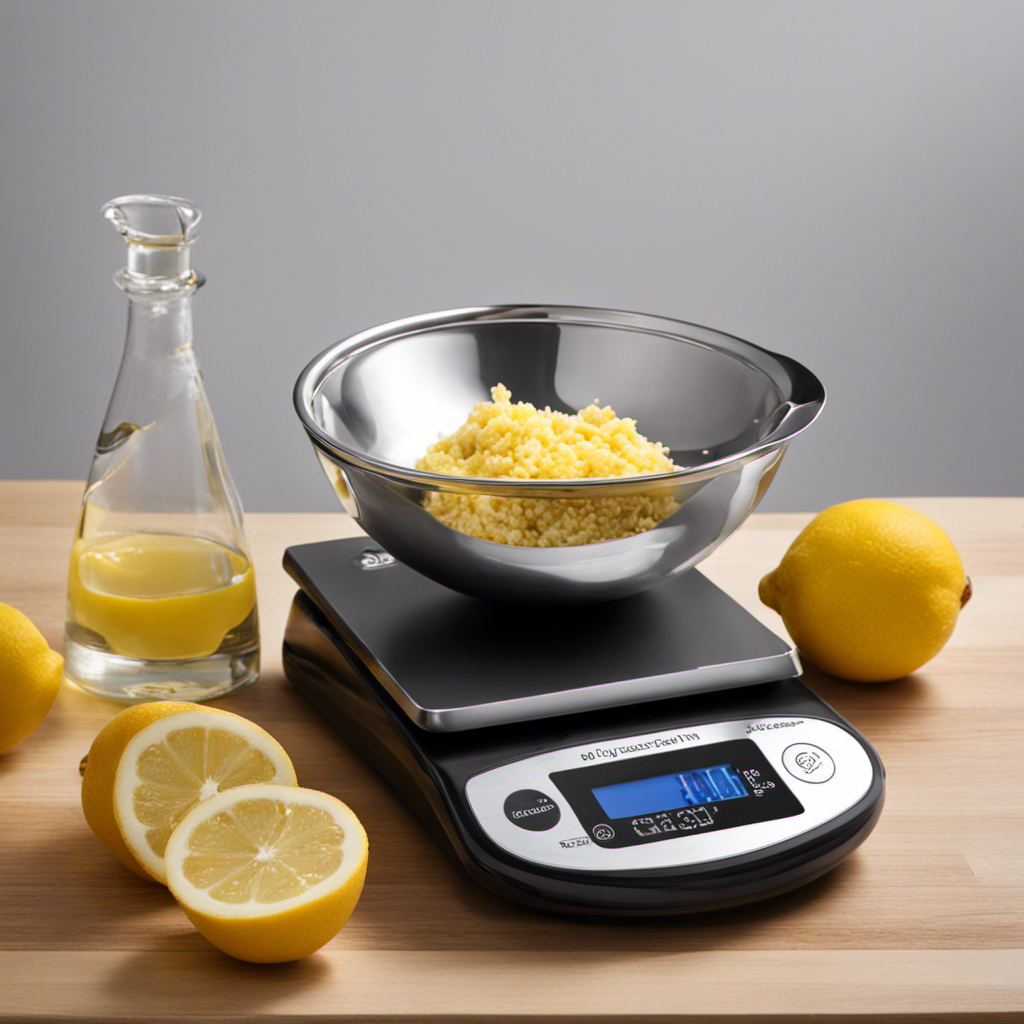I’ve always been fascinated by the process of stirring almond butter, as a fan of all things nutty and delicious. It’s truly satisfying to see plain almonds turn into a creamy spread that is both versatile and nutritious.
In this article, I will guide you through the process, sharing tips and techniques to help you achieve the perfect almond butter consistency.
So grab your favorite almonds and get ready to embark on a culinary adventure that will elevate your nut butter game to new heights.
Key Takeaways
- Stir almond butter only when it is completely cooled after roasting
- Roasting almonds enhances the texture and spreadability of almond butter
- Blending the roasted almonds produces a smoother and creamier consistency
- Proper storage of almond butter is important to maintain its freshness and prevent issues.
Choosing the Right Almonds
To make the best almond butter, you’ll want to choose the right almonds. When it comes to choosing almond varieties, there are a few factors to consider. Firstly, look for almonds that are labeled as ‘raw’ or ‘natural,’ as these will yield the best results. Avoid roasted or flavored almonds, as they may alter the taste of your almond butter. Additionally, consider the size of the almonds. Smaller almonds tend to blend more easily and create a smoother texture.
After selecting the almonds, proper storage is crucial to maintain their freshness and flavor. It is recommended to store almonds in an airtight container in a cool, dark place, such as the pantry or refrigerator. This helps to prevent the nuts from becoming rancid or losing their natural oils. Avoid storing them in humid environments, as moisture can cause them to spoil quickly.
Now that you have chosen the right almonds and stored them properly, it’s time to prepare them for stirring.
Preparing the Almonds for Stirring
Before you begin, make sure you have properly roasted and cooled the almonds.
Choosing the right almonds and using proper roasting techniques are essential for preparing the almonds for stirring almond butter.
When selecting almonds for making almond butter, it’s best to choose raw, unsalted almonds. This ensures that you have control over the flavor and sodium content of your almond butter.
Roasting the almonds adds depth and enhances their natural nutty flavor. To roast the almonds, preheat your oven to 350°F (175°C) and spread the almonds evenly on a baking sheet. Roast for about 10-15 minutes, or until they turn golden brown and emit a nutty aroma.
Allow the almonds to cool completely before proceeding with the almond butter stirring process. Properly roasted and cooled almonds will result in a rich and creamy almond butter.
The Importance of Roasting Almonds
Roasting almonds is a crucial step in enhancing the flavor of almond butter. When almonds are roasted, they release their natural oils, intensifying their nutty taste and creating a richer, more complex flavor profile.
Additionally, roasting almonds helps improve the texture and spreadability of the resulting almond butter, making it easier to spread on toast or incorporate into recipes.
Enhancing Flavor Through Roasting
When you roast almonds, their natural oils are released, intensifying the flavor of the almond butter. Roasting not only enhances the aroma of the almonds but also brings out their natural sweetness. Here are three reasons why roasting almonds is beneficial when making almond butter:
-
Enhanced flavor: Roasting almonds deepens their flavor profile, resulting in a rich and nutty taste that adds depth to your almond butter.
-
Nutritional benefits: Roasting almonds can increase the bioavailability of nutrients, making them easier for your body to absorb. It also helps break down phytic acid, which can hinder mineral absorption.
-
Improved texture: Roasting almonds can give your almond butter a smoother and creamier texture, making it easier to spread and enjoy on toast or as a dip for fruits and vegetables.
Improving Texture and Spreadability
To achieve a smoother and easier-to-spread texture, simply roast the almonds. Roasting not only enhances the flavor of the almond butter but also improves its consistency.
When almonds are roasted, the oils within them are released, making them easier to blend into a creamy butter. The heat from the roasting process helps break down the almonds’ cellular structure, resulting in a smoother texture.
This reduction in oil separation is particularly beneficial for those who prefer a more homogenous almond butter, as it prevents the oil from settling on top. By roasting the almonds before making almond butter, you can achieve a delicious spread with improved consistency and reduced oil separation.
Techniques for Achieving Creamy Almond Butter
When it comes to making almond butter, two key factors to consider are blending versus grinding and using roasted versus raw almonds.
Blending and grinding both involve breaking down the almonds to create a smooth, creamy texture, but blending tends to be more efficient and results in a finer consistency.
As for roasted versus raw almonds, roasting enhances the flavor and brings out the natural oils, resulting in a richer and more flavorful almond butter. However, raw almonds can also be used for a more mild and natural taste.
Ultimately, the choice between blending versus grinding and roasted versus raw depends on personal preference and desired outcome.
Blending Vs. Grinding
If you want creamy almond butter, blending is the way to go. Blending techniques are superior to grinding methods when it comes to achieving a smooth and creamy texture. Here are some reasons why blending is the better option:
-
Blending allows for better control over the consistency of the almond butter. You can start with a coarse grind and gradually blend it to a smooth texture, according to your preference.
-
Blending helps to release the natural oils present in the almonds, resulting in a creamier and more flavorful butter.
-
Blending is more efficient and faster than grinding. With a powerful blender, you can achieve the desired consistency in a shorter amount of time.
Roasted Vs. Raw
In my quest to create the perfect almond butter, I couldn’t help but wonder about the benefits of using roasted almonds versus raw ones.
After some research, I discovered that roasted almonds offer a distinct advantage when it comes to flavor. The roasting process enhances the nutty and toasty flavors, resulting in a richer and more satisfying taste. Additionally, roasting almonds can make them easier to blend, as the heat loosens their natural oils.
However, it’s important to note that roasting almonds may slightly reduce their nutritional content compared to raw almonds. Raw almonds are packed with enzymes and nutrients that can be affected by the roasting process. Nevertheless, the difference is minimal, and the taste benefits of roasted almonds often outweigh these slight nutritional differences.
Now that we understand the roasted versus raw debate, let’s move on to the next section and explore ways to add flavor and variety to almond butter.
Adding Flavor and Variety to Almond Butter
To enhance the taste of your almond butter, try mixing in some honey or cinnamon. These delicious additions can take your plain almond butter to a whole new level of flavor.
Here are some other nut butter combinations that you can try to add even more variety to your almond butter:
- Add a tablespoon of cocoa powder for a rich and chocolatey taste.
- Mix in some chopped nuts, like walnuts or pecans, for added crunch.
- For a tropical twist, blend in some shredded coconut or a squeeze of lime juice.
How to Store Almond Butter Properly
After experimenting with different flavors and ingredients to enhance the taste of almond butter, it’s important to know how to properly store it. Proper storage not only helps maintain its freshness but also prevents separation. Almond butter is prone to separation because it lacks the stabilizers found in commercial peanut butter. To prevent separation, store your almond butter in a cool, dry place, away from direct sunlight. It’s best to store it in a tightly sealed jar or container to minimize exposure to air and moisture. If you want to extend its shelf life, you can also refrigerate it, although this may result in a slightly firmer texture. By following these storage tips, you can enjoy your almond butter without worrying about separation.
To summarize, here are some key points for proper storage of almond butter:
| Store in a cool, dry place | Away from direct sunlight | Tightly sealed jar or container | Refrigerate for extended shelf life |
|---|---|---|---|
| Prevents separation | Maintains freshness | Minimizes exposure to air | May result in firmer texture |
Troubleshooting Common Almond Butter Issues
If you’re experiencing issues with separation or a gritty texture, try adding a small amount of oil and blending it well. Almond butter can sometimes present common problems, but with a few troubleshooting tips, you can easily solve them.
Here are some helpful suggestions:
-
If your almond butter is too dry or thick, try adding a teaspoon of oil, such as almond or coconut oil, to the mixture. This will help to improve the spreadability and creaminess of the butter.
-
If your almond butter is too runny or oily, try refrigerating it for a few hours. This will help it to firm up and become easier to use.
-
If your almond butter has a bitter taste, it may be due to the almonds being roasted for too long. Try using raw almonds instead or roasting them for a shorter period of time.
Using Almond Butter in Recipes
Now that we have covered troubleshooting common almond butter issues, let’s explore the exciting ways you can use almond butter in recipes. Almond butter is not just a spread for toast; it can be a versatile ingredient that adds richness and flavor to various dishes.
One popular way to enjoy almond butter is by using it as a dip. Its creamy texture and nutty taste make it an excellent choice for pairing with fruits, vegetables, or even pretzels. You can also incorporate almond butter into desserts, such as cookies, brownies, or even smoothies. Its natural sweetness and nutty undertones can enhance the overall flavor profile of your favorite treats.
To give you some inspiration, here’s a table showcasing three delicious recipes that incorporate almond butter:
| Recipe | Ingredients | Instructions |
|---|---|---|
| Almond Butter Dip | Almond butter, honey, vanilla extract | 1. In a bowl, mix almond butter, honey, and vanilla extract until well combined. Serve as a dip. |
| Almond Butter Cookies | Almond butter, eggs, sugar, flour | 1. Preheat oven to 350°F. 2. In a bowl, mix almond butter, eggs, sugar, and flour. 3. Shape into cookies and bake for 10-12 minutes. |
| Almond Butter Smoothie | Almond butter, banana, almond milk | 1. Blend almond butter, banana, and almond milk until smooth. Enjoy as a refreshing smoothie. |
Exploring Alternative Nut Butters
You can explore alternative nut butters, like cashew or peanut butter, for different flavors and textures in your recipes. Here are some creative uses and health benefits of these delicious alternatives:
-
Cashew Butter
-
Use it as a creamy base for sauces or dressings.
-
Spread it on toast with sliced bananas for a tasty and nutritious snack.
-
Cashew butter is rich in monounsaturated fats, which can help lower bad cholesterol levels.
-
Peanut Butter
-
Blend it with coconut milk and curry paste for a flavorful peanut sauce.
-
Add a dollop to smoothies for a protein boost.
-
Peanut butter is packed with protein, fiber, and healthy fats, making it a satisfying and nutritious choice.
-
Almond Butter
-
Mix it with honey and oats to create energy balls for a quick and healthy snack on the go.
-
Spread it on apple slices or celery for a crunchy and nutritious treat.
-
Almond butter is a great source of vitamin E and magnesium, which are important for overall health.
Exploring these alternative nut butters not only adds variety to your recipes but also provides unique health benefits. So, go ahead and get creative in the kitchen!
Frequently Asked Questions
Can I Use Any Type of Almonds to Make Almond Butter?
Yes, you can use different types of almonds to make almond butter. However, roasting the almonds before blending them can enhance the flavor and make the butter smoother.
How Long Should I Roast the Almonds for Before Stirring?
Roasting time for almonds before stirring? About 10-15 minutes at 350°F, or until they turn golden brown. But hey, if you’re not into roasting, try using toasted almonds as an alternative for that nutty flavor!
Can I Make Almond Butter Without Roasting the Almonds?
Yes, it is possible to make almond butter without roasting the almonds. However, the taste and texture may be different. Exploring alternative methods like soaking, blanching, or sprouting almonds can help achieve desired results.
Can I Add Other Ingredients to My Almond Butter to Enhance the Flavor?
Adding spices and sweeteners to almond butter can enhance its flavor. Incorporating different nuts can also create a unique taste. It’s an exciting journey of experimentation and discovery in the world of almond butter.
How Long Can Almond Butter Be Stored and How Should It Be Stored to Maintain Freshness?
To maintain freshness, store almond butter in an airtight container in a cool, dark place like the pantry. It can last for several months, but check for signs of spoilage like off smells or mold.
Conclusion
In conclusion, stirring almond butter is a simple and rewarding process. By choosing the right almonds and properly preparing them, you can achieve a creamy and delicious result.
Roasting the almonds is crucial for enhancing the flavor and achieving the desired texture. Adding different flavors and experimenting with alternative nut butters can bring excitement and variety to your almond butter creations.
Remember to store your almond butter properly to maintain its freshness. So why wait? Grab your almonds and get stirring for a nuttylicious treat!










